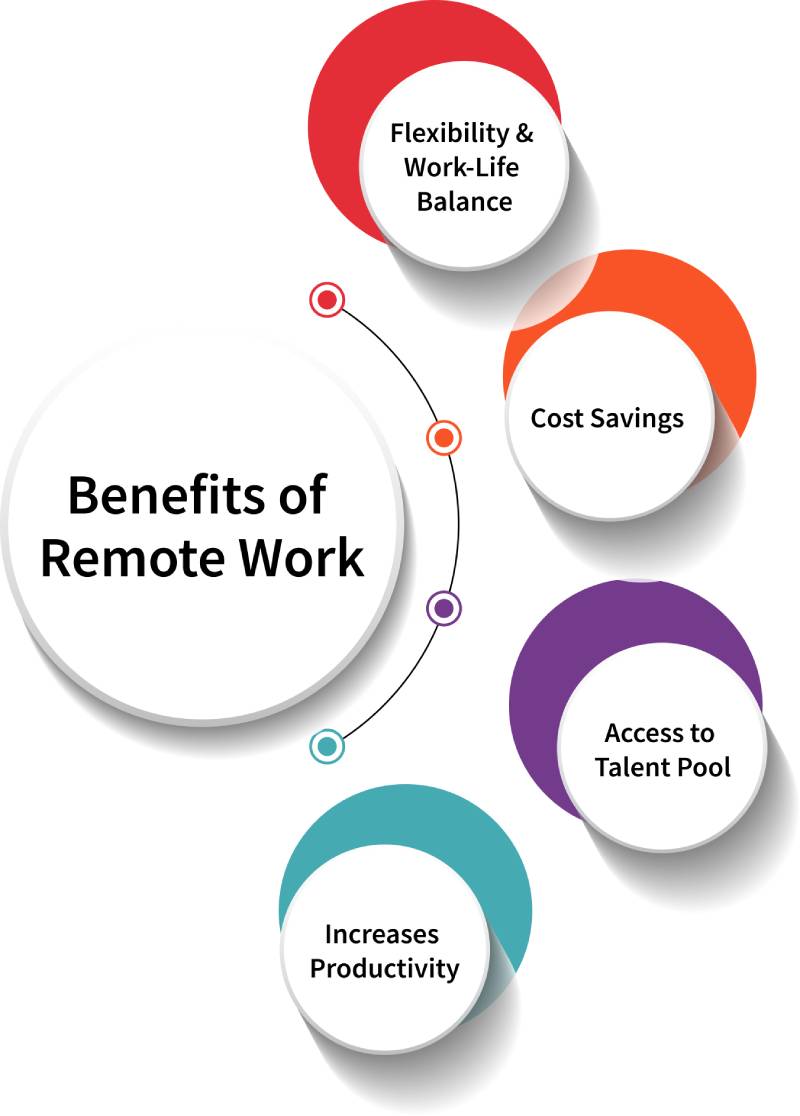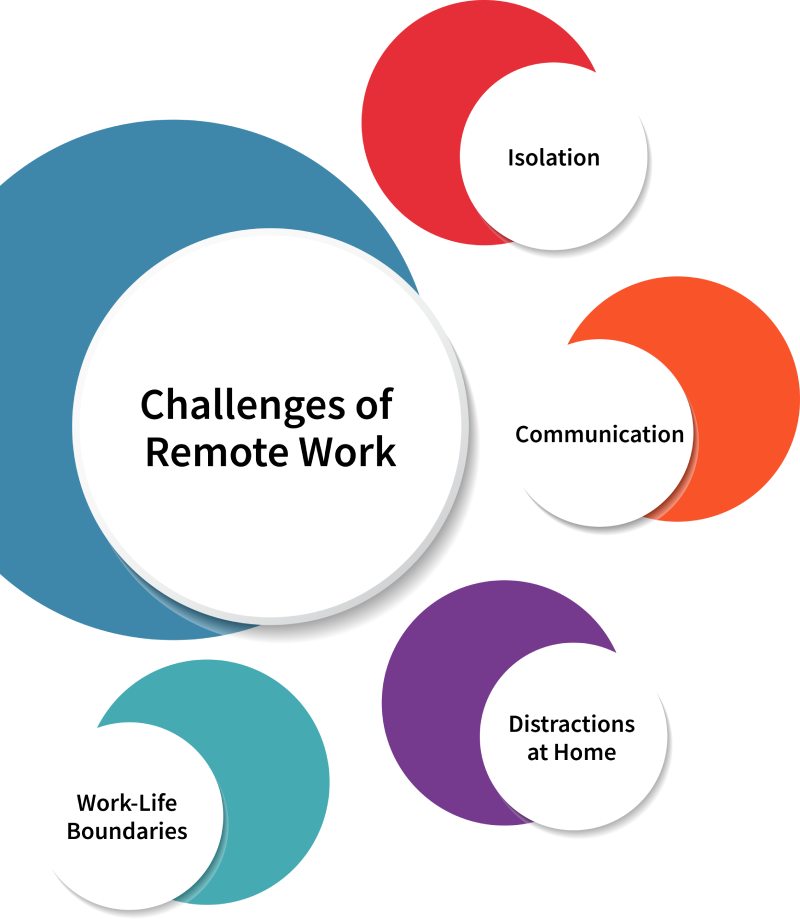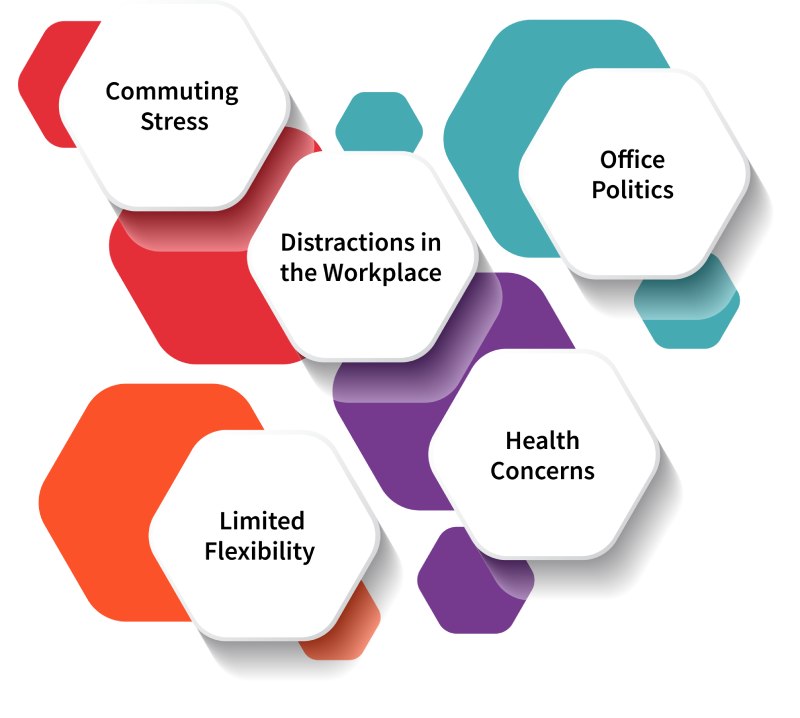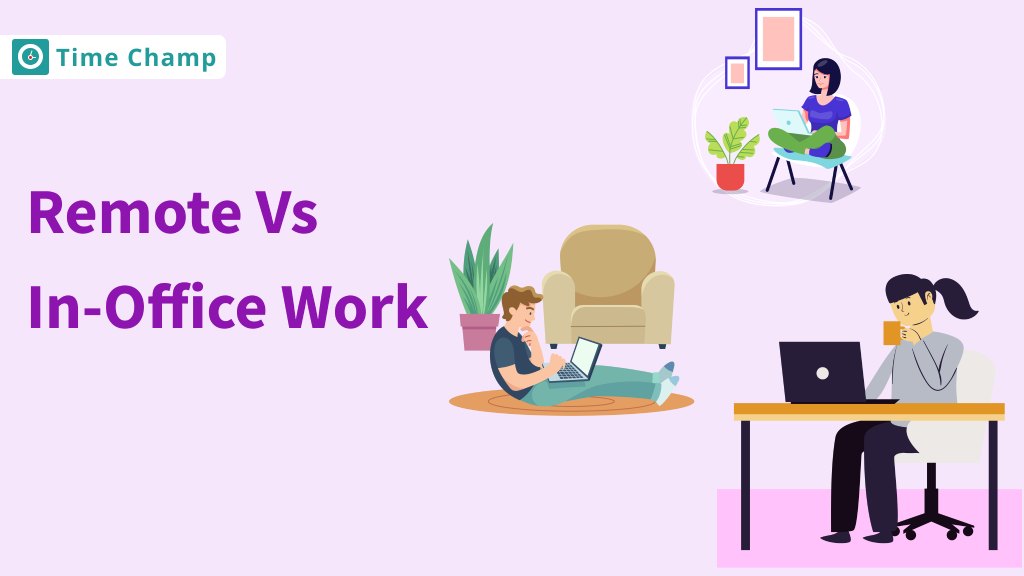Choosing between remote work and in-office work feels overwhelming, right? Which is the best option, you may be unsure. Both offer unique benefits and challenges. Finding the right fit depends on your personal preferences and professional needs. In this blog, we will explore remote vs in-office work, pros and cons, and factors to consider choose which work environment fits you best!
Let’s dive in!
What is Remote Work?
Remote work is when employees do their jobs from home or another location instead of being in a regular office. It offers flexibility to employees in work hours and location.
According to a study by Great Place To Work, over 800,000 employees from 500 companies over two years reported that their productivity increased after they began working from home. According to Global Workplace Analytics, remote work builds a healthy environment for employees to succeed.
What is In-Office Work?
In-office work refers to an arrangement where employees perform their job duties from a physical office location rather than remotely. This traditional setup typically involves employees coming into the office on scheduled days and collaborating with colleagues face-to-face.
Office work allows for direct communication, spontaneous interactions, and a structured work environment. It can foster teamwork and strengthen relationships among team members.
Comparing Remote vs In-Office Work
| Factor | Remote Work | In-Office Work |
|---|---|---|
|
Flexibility
|
Greater
flexibility
in hours
and
environment.
|
Generally
fixed
schedule
with
limited
flexibility.
|
|
Communication
|
Relies
on
digital
tools;
may lead
to
misunderstandings.
|
Encourages
spontaneous
conversations
and
real-time
collaboration.
|
|
Distractions
|
Household
tasks
and
family
interruptions
can
distract.
|
Office
noise
and
interruptions
from
co-workers
can
hinder
focus.
|
|
Social
Interaction
|
This may
lead to
feelings
of
isolation;
building
relationships
requires
more
effort.
|
Fosters
a sense
of
community
and team
spirit.
|
|
Work-Life
Balance
|
Potential
for
better
balance
with
flexible
schedules.
|
Fixed
schedules
and
commuting
may
limit
personal
time.
|
|
Productivity
|
Varies;
some
thrive,
while
others
struggle
with
structure.
|
Provides
a
structured
environment
that can
enhance
focus.
|
|
Health
and
Well-Being
|
Can
improve
mental
well-being;
risk of
loneliness
if
social
interactions
are
lacking.
|
Offers
social
support
but may
expose
employees
to
office
stress.
|
Benefits of Remote Work
Let’s take a look at some of the benefits of remote work which offers both employers and employees:

1. Flexibility & Work-Life Balance
The main advantage of working remotely is flexibility. Let your employees be able to choose where they work and set their schedules to fit their lives. This freedom doesn’t just make your employees happier but also enhances their engagement with their work.
According to Flex Jobs, Mental Health America Survey, 48% of the employees said that their work-life balance improved better with flexible options in their work, compared to 36% of employees without flexibility.
Flexibility makes your team to balance their work and personal life. They can handle family needs or take a quick break anytime they want. When your team finds that balance, they often feel more relaxed and can get more work done.
2. Cost Savings
Do you know how remote work can help you save money?
You might be surprised just how much those savings can add up! First, think about the costs associated with your office. With fewer employees in the office daily, you will notice savings on utilities and supplies.
That’s money you can reinvest in your team or other projects. Your employees will also save money. They won’t need to spend on public transportation or parking fees. And also, they can cut back on work clothes and food.
3. Access to Talent Pool
Remote work lets you hire people from anywhere without worrying about where they live. You can reach talented professionals from anywhere, giving you more choices when building your team.
By offering work-from-home jobs, you are not just expanding your reach, you are finding people who truly fit your company’s needs, no matter where they live. It allows you to find the right talent without being restricted to one location.
4. Increases Productivity
Have you noticed how many remote workers say they feel more productive at home?
According to OWL LABS, State Remote Work Report, employees who work remotely are 24% more satisfied in their job roles and more productive than the employees who don’t work remotely.
Without office distractions, your team can focus on their tasks and complete more work effectively at their own pace. Having remote employees who are more productive translates into great benefits for your business.
Challenges of Remote Work

1. Isolation
Remote work can often feel isolating for your employees. When employees are working from home, they may feel disconnected from team members due to a lack of daily interactions. It leads to loneliness, making it harder for them to stay motivated and engaged. As an employer, it’s important to understand your employees’ feelings and look for ways to help your team connect.
2. Communication
Effective communication can be a real challenge when working remotely. Without face-to-face conversations, they can miss important information, which leads to confusion and frustration. It’s important to set up clear ways for your team to communicate. Encourage your teams to share their thoughts so that everyone stays informed.
3. Distractions at Home
Working from home gives your team more flexibility, but it can also bring many distractions. Things like household tasks, family duties, and unexpected interruptions can distract your employees from their work. These work from home distractions make it hard for them to focus on their tasks. It’s important to help your team find ways to handle these issues so they can be more productive.
4. Work-Life Boundaries
Blurring the lines between work and personal life can be a significant issue for remote workers. Without a clear separation, employees may find themselves working longer hours or struggling to switch off after work. It leads to burnout and decreases employee job satisfaction. You should encourage your team to set boundaries. This helps them keep a healthy balance between work and their personal lives.
Benefits of In-Office Work
Let’s take a look at some of the benefits of in-office work:
1. Enhances Collaboration:
Working in a shared physical space boosts your team dynamics. Spontaneous conversations happen naturally, sparking creativity and innovation. It’s incredible how a simple chat over coffee can lead to the best ideas. Collaboration flourishes when your team members can easily share thoughts and provide feedback. You will find that brainstorming sessions become more productive and engaging. Ultimately, fostering this environment can drive your team’s success to new heights!
2. Clear Communication:
In-office work fosters clear communication among your team. When employees interact face-to-face, there’s less room for misunderstanding. Body language and tone add context to conversations that emails can’t capture. Having your team together also builds stronger relationships. Personal connections can spark collaboration and creativity. Bringing everyone under one roof can enhance productivity as well.
3. Stronger Relationships:
When colleagues share the same space, they naturally bond over casual conversations and shared experiences. These connections improve collaboration and create a more harmonious workplace. Strong relationships promote clear communication and mutual trust, enabling the team to address challenges collaboratively. Additionally, a sense of belonging can enhance your remote employee motivation and engagement. Prioritizing in-office work contributes to the overall success of your team!
4. Structured Environment:
Office work provides a structured environment that enhances your productivity. With defined workspaces, your employees can stay focused and engaged. This setup minimizes distractions and encourages collaboration among your team members. Moreover, being in the office enhances communication. It allows for quick problem-solving. These interactions strengthen relationships and build a cohesive team culture, ultimately driving your business success.
5. Opportunities for Learning:
Physical workspace offers a fantastic chance for your employees to learn from one another. When employees are physically together, mentoring happens naturally. This real-time interaction helps everyone pick up new skills and knowledge effortlessly. On-the-job training thrives in this environment. It improves collaboration and encourages the sharing of ideas. When your team can learn side by side, they are not just growing individually but also strengthening your overall workforce .
Challenges of In-Office Work

1. Commuting Stress
Commuting can be a real headache for your employees. Long hours stuck in traffic add stress before the workday even begins. This tension often carries over into the workplace, affecting productivity. You can help reduce this issue by considering flexible hours. Even small changes can make a big difference in how your team feels. A happier, less stressed workforce is ready to tackle challenges head-on!
2. Distractions in the Workplace
Distractions can be a real problem in the office. Whether it’s chatting at the coffee machine or ringing phones, these interruptions can disrupt focus. It’s essential to create an environment where your employees can concentrate and produce their best work. To tackle this, consider implementing quiet hours or designated collaboration zones. A simple layout change can foster productivity and minimize noise. Your team will appreciate the thought, and you’ll notice a boost in their overall efficiency!
3. Limited Flexibility
In-office work often comes with fixed hours and rigid schedules. This structure can stifle creativity and leave employees feeling trapped. Offering more flexibility can boost morale and productivity. Consider letting employees choose their hours or work from home occasionally. A little freedom can rejuvenate your team. It shows you trust them, which goes a long way in building loyalty.
4. Office Politics
Office politics can be a hidden danger in a traditional workspace. Employees may feel pressured to navigate complicated relationships, leading to stress and conflict. This environment can lower job satisfaction and impact teamwork. Encouraging open communication can help mitigate these issues. Promote a culture of collaboration where ideas are valued, not just seniority. A supportive atmosphere fosters healthy relationships and a stronger team dynamic.
5. Health Concerns
Health issues are rising due to crowded offices and shared workspaces. From the spread of infections to mental health challenges, these concerns are real. Employers need to prioritize the well-being of their teams. Implementing hygiene protocols and offering mental health resources can make a significant difference. Show your employees you care about their health, and they’ll likely reciprocate with increased loyalty and productivity.
Factors to Consider When Choosing Your Work Environment
Choosing the right work environment is crucial for both productivity and job satisfaction. As you think about where you and your team will be most effective, consider these key factors:

1. Job Role and Industry
When considering a work environment, consider the specific job roles you are hiring for. Different industries have unique demands, and the workspace should reflect those needs. A creative role may thrive in an open and collaborative space, while technical jobs might benefit from quieter, focused environments.
It’s crucial to align the work environment with the nature of the job. This creates satisfaction and enhances productivity. You should assess the best setups that foster success in each role. Knowing the role can guide decisions that make a real difference.
2. Personal Work Style and Preferences
Every employee has a unique work style, which should influence your environment choice. Some team members thrive in bustling spaces, while others may need a calm atmosphere for optimal focus. Understanding these preferences helps create a space that makes everyone feel comfortable.
Tailoring the environment to meet diverse work styles can boost team spirit. Happy employees are usually more engaged. A blend of collaborative zones and quiet areas can cater to various preferences, making your workplace more inviting for all.
3. Company Culture and Policies
Company culture significantly shapes the work environment you provide. It’s essential to have policies that reflect your values and support your team. If creativity is a core value, an inspiring and flexible space can cultivate that spirit.
Remember that culture isn’t just about benefits; it’s about creating a community. Your employees should feel that they belong and can express themselves freely. A thoughtful environment encourages this sense of belonging, helping your company thrive.
4. Commute and Location
Location plays a vital role in employee satisfaction. Consider how easy it is for your team to commute to the office. A convenient, accessible location can greatly affect their daily experience and productivity.
Moreover, remote work options are now more important than ever. Offering flexibility can attract top talent who prioritize work-life balance. Whether in-house or remote, your workforce should feel supported no matter where they are located.
5. Technology and Resources
The right technology is essential for a modern work environment. Ensure that your team has access to the tools they need to perform efficiently. From software to hardware, a well-equipped workspace makes everyday tasks easier. Effective IT asset management plays a key role in maintaining and optimizing these tools, ensuring everything runs smoothly and resources are used wisely.
Additionally, keep asking for feedback on the tools and resources provided. Your team’s input is invaluable. By regularly updating and enhancing technology, you reinforce that you care about their success and well-being.
Final Thoughts: Finding the Right Fit for You
Choosing the right work environment depends on your job role, lifestyle, and personal preferences. There’s no single solution that works for everyone. Remote work gives you flexibility and comfort, while in-office work offers structure and easy collaboration.
When deciding, consider what suits you and your team best. Look at your daily needs, your company’s culture, and the nature of your work. The key is to choose an environment where you feel productive, engaged, and satisfied.
Try Time Champ today to keep productivity high, no matter where your team works!
Signup for FreeBook DemoFrequently Asked Questions
Productivity can vary depending on the individual and their work style. Remote work offers flexibility and a quiet setting, which can boost focus for some employees. However, in-office work provides immediate access to colleagues, fostering quicker collaboration and decision-making.
In remote work, communication can be challenging due to the lack of face-to-face interaction. In-office work, however, benefits from spontaneous conversations and immediate feedback but can also suffer from information overload due to constant interruptions.
Collaboration in a remote setting often depends on using technology like video calls and project management tools to stay connected. In-office work allows for quick, in-person brainstorming sessions and easy collaboration but can also lead to frequent distractions.
Yes, there can be significant cost differences. Remote work can reduce overhead expenses for employers, as there’s less need for office space, utilities, and other physical resources. In-office work, while offering the benefit of centralized operations, typically involves higher operational costs, including office rent, utilities, and supplies.






